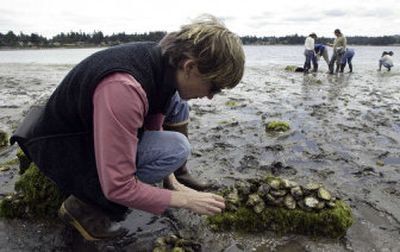An appeal to the public’s appetite

BREMERTON – Ankle-deep in the briny muck of a low-tide beach, Brady Blake’s hunt for bits of hard-shelled treasure has ended.
Just as the state shellfish biologist hoped, this sandy stretch near an old Navy pier is home to Olympia oysters – the Pacific Northwest’s only native variety.
“This is an amazing find,” Blake says, surveying fat clusters of greenish-grey Olympias clinging to rocks, concrete chunks and other shellfish.
These tiny, delicate oysters once blanketed beaches along the winding shores of Puget Sound. But like other sea creatures that have fed generations here, the Olympia was hit hard by harvesting, pollution and a growing human population.
Now, with help from shellfish farmers and concerned citizens alike, the native oyster is staging a comeback – proof, some say, that Puget Sound’s edible bounty is a powerful draw for public action. What better way to the people’s hearts than through their stomachs?
“We can say, ‘We need to restore this pristine wilderness.’ It just doesn’t motivate people,” said David G. Gordon, co-author of “Heaven on the Half Shell,” a book about Northwest oyster history. “If you say, ‘If you like to eat oysters, then you’ve got to get your act together,’ then they’ll get motivated.”
That’s the kind of message officials working on Gov. Chris Gregoire’s ambitious Puget Sound cleanup initiative are looking for – something that prompts broad swaths of the public to get involved. Without a turnaround in public support, officials warn, the entire conservation plan may not get off the ground.
“If we aren’t able to better communicate with people about the severity of problems around Puget Sound and inspire them to take action, I’m not sure we can win,” said Brad Ack, director of Gregoire’s Puget Sound Action Team.
Fish of all kinds are deeply rooted in the culture of Washington state, where the largest population centers crowd around Puget Sound’s 2,500 miles of shoreline.
Fishing the open water and collecting shellfish from the beach are cherished pastimes, and urban Northwesterners also are a famously outdoorsy bunch with a general soft spot for environmental causes. So it was surprising this month when officials leading the new cleanup effort reported that most people surveyed believed Puget Sound’s health was just fine.
In reality, scientists warn, the Sound carries sediment tainted by old-line industry alongside growing threats from urban runoff, sewage and wastewater. Salmon runs are in trouble, and the area is critical habitat for endangered killer whales.
For people like Betsy Peabody, executive director of the Puget Sound Restoration Fund, that’s where shellfish come in.
Efforts such as native oyster restoration can draw on the history and culture of the Sound to attract people who might not otherwise get involved, she said.
“Many people who are involved in this project, they don’t come at it necessarily from an environmental point of view. They come at it because they remember eating Olympia oysters back when they were young, or they remember hearing about their parents or their grandparents eating them,” she said.
The state’s multimillion-dollar shellfish industry agrees, with leading growers like Taylor Shellfish Farms reaching the public through oyster recovery and a push to establish small, private shellfish beds.
“I think that’s just a superb way to create a lot of interest in keeping the water clean and creating water-quality lobbyists in bigger numbers,” said Jon Rowley, a seafood authority from Seattle who works with Taylor Shellfish. “If somebody’s out there raising a little shellfish farm, they’re going to want to protect them and they’re going to want to be able to eat them.”